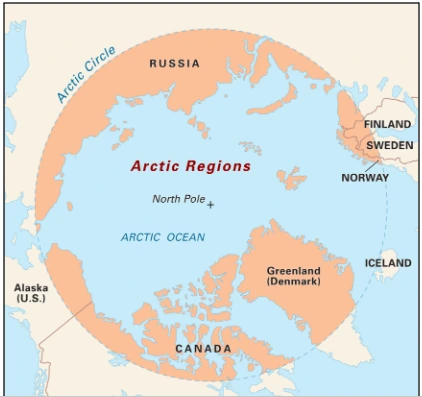International observers warn that escalating tensions in the Arctic could lead to conflicts if not addressed.
About the Arctic
- The Arctic is the northernmost region of Earth, centered around the North Pole.
- It includes parts of Canada, Denmark (Greenland), Finland, Iceland, Norway, Russia, Sweden, and the U.S. (Alaska).
- The region is covered by sea ice, tundra, and glaciers, playing a crucial role in global climate regulation.
- Geographical Extent and Climate: The Arctic spans the Arctic Ocean and surrounding lands above the Arctic Circle (66.5°N latitude).
- It experiences extreme cold, with long winters and short summers.
- Due to climate change, ice caps are melting, impacting ecosystems and opening new trade routes.
 Vegetation and Wildlife: Arctic vegetation includes mosses, lichens, shrubs, and tundra grasses that survive in frozen soil (permafrost).
Vegetation and Wildlife: Arctic vegetation includes mosses, lichens, shrubs, and tundra grasses that survive in frozen soil (permafrost).-
- Wildlife includes polar bears, Arctic foxes, reindeer, walruses, seals, and whales.
- Birds such as snowy owls and Arctic terns migrate vast distances.
- Human Presence and Conservation: Indigenous communities like the Inuit and Sámi have adapted to the harsh Arctic environment.
- The Arctic Council oversees environmental protection and sustainable development.
- Melting ice is increasing competition for natural resources, raising geopolitical tensions.
Strategic Importance of the Arctic
- The Arctic holds vast untapped natural resources, including fossil fuels, rare earth elements, and valuable fisheries.
- Melting ice opens new trade routes, such as the Northwest Passage and Northeast Passage, reducing maritime distances for global trade.
- The region is governed by the UN Convention on the Law of the Sea (UNCLOS) but lacks a dedicated treaty for demilitarization and environmental protection.
Control Over the Region
- The Arctic Council includes eight nations, Canada, Denmark (Greenland), Finland, Iceland, Norway, Russia, Sweden, and the U.S.
- These nations have sovereignty over Arctic land and control resources within their Exclusive Economic Zones (EEZs).
- UNCLOS allows nations to extend claims beyond their 200-nautical-mile EEZ if they prove it is a continuation of their continental shelf.
Key Areas of Tension
Greenland Dispute
- The U.S. has shown interest in acquiring Greenland, citing national security concerns.
- Denmark, which controls Greenland, has rejected these claims and strengthened its military presence on the island.
Northwest Passage Conflict
- Canada considers the Northwest Passage as its internal waters, while the U.S. insists it is an international shipping route.
- This disagreement raises concerns over navigation rights, environmental policies, and sovereignty.
Russia’s Arctic Expansion
- Russia has the largest fleet of icebreakers, including nuclear-powered ones, giving it a military and logistical advantage.
- Moscow has revived Soviet-era Arctic military bases and conducted joint naval exercises with China in the East China Sea.
- Russian officials have hinted at territorial claims over Norway’s Svalbard Island, increasing tensions with NATO countries.
NATO’s Response
- Sweden and Finland joined NATO after Russia’s invasion of Ukraine, intensifying the alliance’s military presence in the Arctic.
- NATO has conducted large-scale military exercises near the Russian border in Finland.
- The Greenland-Iceland-U.K. (GIUK) gap is a key naval choke point for NATO’s defense against potential Russian incursions.
Economic and Strategic Interests
- Energy Resource Potential: A 2009 U.S. The Geological Survey estimated that the Arctic contains 13% of the world’s undiscovered oil and 30% of untapped natural gas reserves.
- Rech Mineral deposits: Greenland has rich rare earth mineral deposits, attracting interest from global investors, including China.
New Trade Routes
- The Northeast Passage along Russia’s Arctic coast could shorten the maritime route between East Asia and Europe by 8,000 km compared to the Suez Canal route.
- China has shown interest in developing a Polar Silk Road but requires Russian cooperation for Arctic port access.
Future Outlook
- Russia’s symbolic planting of a flag on the North Pole seabed (2007) signaled its Arctic ambitions.
- China, declaring itself a Near-Arctic State (2018), plans to build a nuclear-powered icebreaker.
- NATO’s Arctic military limitations raise concerns about security imbalances.
- Rising global temperatures will further open the Arctic, intensifying competition and geopolitical conflicts.
Tensions in the Arctic continue to grow as nations compete for control, resources, and strategic advantages in this rapidly changing region.
![]() 1 Apr 2025
1 Apr 2025

 Vegetation and Wildlife: Arctic vegetation includes mosses, lichens, shrubs, and tundra grasses that survive in frozen soil (permafrost).
Vegetation and Wildlife: Arctic vegetation includes mosses, lichens, shrubs, and tundra grasses that survive in frozen soil (permafrost).